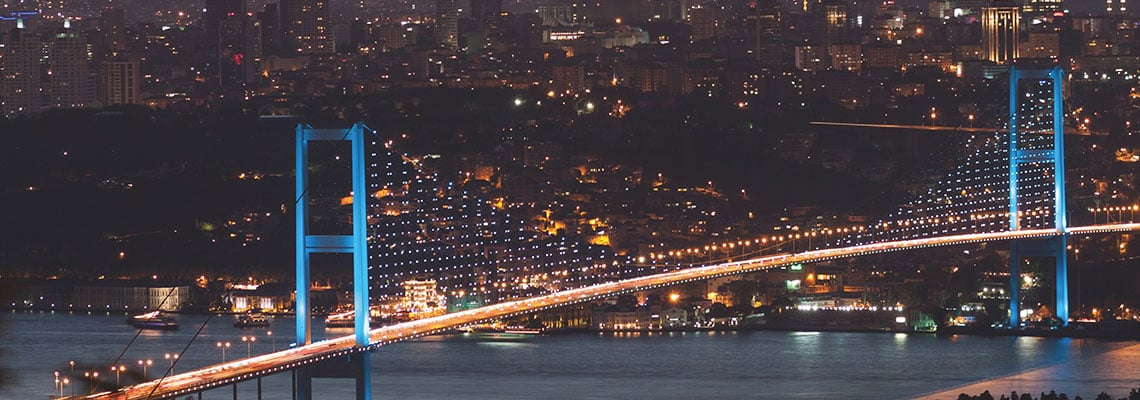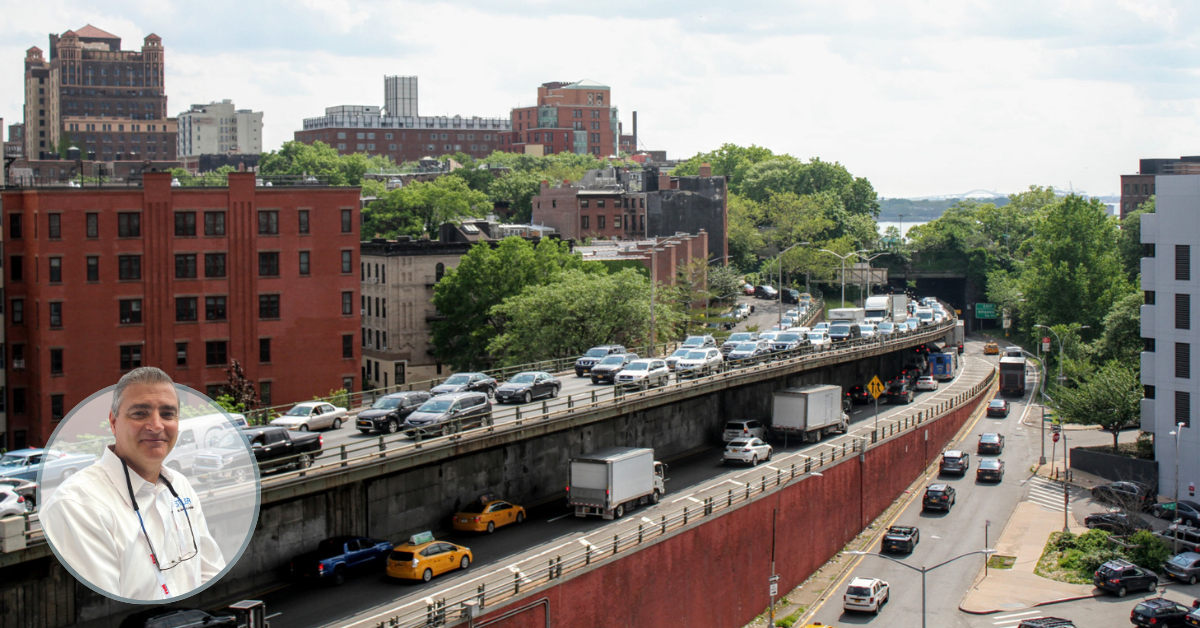Crossing continents

Source: Intertraffic Worldwide Magazine
Istanbul’s Bosphorus Bridge is a key part of the city’s infrastructure, and while 2016’s military coup failed to claim it, road authorities are still preparing for its potential destruction – by an earthquake. The bridge has been officially renamed 15 July Martyrs’ Bridge after the failed military coup in 2016
Rarely does highway infrastructure become the star of global news events. Normally it gets built, used and quickly assimilated into the everyday landscape of people’s lives. The Bosphorous Bridge, however, hit the headlines worldwide in July 2016, inadvertently highlighting just how crucial specific sections of road networks can be
to the peace and stability of entire nations.
Military officers attempted a coup to overthrow the government of President Tayyip Erdogan, and part of their strategy was to barricade the 1,500m-long suspension bridge, excluding everyone from the eight-lane tolled crossing that links the European and Asian parts of Istanbul. But crowds responded to the president’s call to take to the streets and halt the coup. They persuaded the officers to surrender the bridge, although some protestors sadly lost their lives. Ten days later a grateful government officially renamed the crossing as 15 July Martyrs’ Bridge.
Quake threat
Threats to this bridge, however, do not come only from people seeking power. The earth itself could devastate a road connection that has worked so hard for Turkey since 1973. With every passing year, the risk of a major earthquake in the region grows, say geologists.
“From an earthquake scientist’s perspective, this is a hot spot for potential seismic hazards,” says Michael Floyd, a research scientist in MIT’s Department of Earth, Atmospheric and Planetary Sciences. Although it’s impossible to pinpoint when such a quake might occur, Floyd says the next one could be powerful, a magnitude of 7 or stronger. “When people talk about when the next quake will be, what they’re really asking is, ‘When will it be, to within a few hours, so that I can evacuate?’ But earthquakes can’t be predicted that way,” Floyd says. “Ultimately, for people’s safety, we encourage them to be prepared. To be prepared, they need to know what to prepare for – that’s where our work can contribute.”
Preparing to make the Bosphorous Bridge safer is challenging. It’s not practical to make the structure itself more resilient without massive investment and disruption, but there are steps that could save the lives of people traveling across it at the moment that the tectonic plates shift unstoppably by an estimated 11ft (3.3m). It may not seem like a huge movement but, along with associated tremors, it could turn the bridge to rubble. With 190,000 crossings daily, peaking at 6,200 per hour, the potential loss of human life is massive if the bridge is rocked.
Protecting traffic
A sensible use of traffic technologies could help to prepare drivers to help themselves when the ground shakes. If the region’s earthquake early warning system (EEWS) is linked to a traffic management network, hundreds lives could be saved in a quake, say researchers at Sakarya University, Turkey. They say that the right ITS could reduce the fatality rate by a massive 95%.
How can an EEWS link to a traffic management system have such a dramatic impact? Traffic speeds are low during peak periods, with vehicles traveling at about 28mph (45km/h, 12.5m/s) on average, so it can take up to 86 seconds for all vehicles to leave the bridge, the researchers calculate. Under current conditions, the region’s EEWS beneath the nearby Sea of Marmara would give only about 14 seconds notice of danger, which is too little time for most drivers to reverse back to, or accelerate forward onto, dry land. So, inevitably, some vehicles will be on the suspended road decks 60m above the water.
Zooming in on the most vulnerable, the researchers have determined that the vehicles at highest risk are those that are caught in a zone within 100m of the middle of the bridge. “The maximum damage will happen in the mid-span,” says Dr Hakan Aslan, co-author of the report Bosporus Bridge traffic operation techniques using real-time earthquake information to mitigate the risk involved, published in Disaster Science and Engineering, vol 1, 17-24 (2015).Getting vehicles off the danger section as quickly as possible and stopping others from entering it is one proposed solution. It would require a dynamic information system, using either variable message signs or color-coded LED lighting. This would prompt drivers to accelerate away from the most vulnerable sections rapidly. Those behind them, on a safer section, would be told to stop, turn round and evacuate to the approach roads, which would be kept clear by automated red traffic signals placed up to 2.5 miles (4km) before the bridge.
The impact of natural disasters is always hard to predict, but detailed calculations show that if no steps are taken and a quake destroys the central 200m during peak traffic, as many as 360 lives could be lost. However, the researchers believe there will be fewer than 16 fatalities if the traffic technologies are put in place and triggered by the EEWS.
Wider impacts
Getting vehicles off the Martyrs’ Bridge and to safety is the researchers’ first step. Then, they want to apply their methods to a wider network. “We’re planning to consider the traffic and geometric conditions of the connecting roads. This will provide more comprehensive strategies,” says Aslan.
Their aims may be assisted if another new study prompts changes in the way Istanbul manages its traffic. It suggests that a combination of congestion charging for the city center and high-occupancy vehicle management on all of the bridge crossings would reduce traffic, improving both journey times and air quality. It may not be surprising that the study is written by experts at Istanbul’s public transport authority, IETT.
Nevertheless, whether to keep the roads effective or to minimize the impact of a natural disaster on major highways, there is a growing belief that Istanbul can help itself by implementing new technologies. “Turkey needs an urgent and effective implementation of an ITS system,” say Dr Pervin Ersoy and Gülmüs Börühan, researchers at Turkey’s Yasar University. “Many transportation problems haven’t been solved in Turkey yet. For this reason, researching and making investment for these new ITS technologies is a main concern for Turkish road transportation.” Without such investment, the roads and bridges of Turkey are at risk of hitting the headlines again – for all the wrong reasons.



